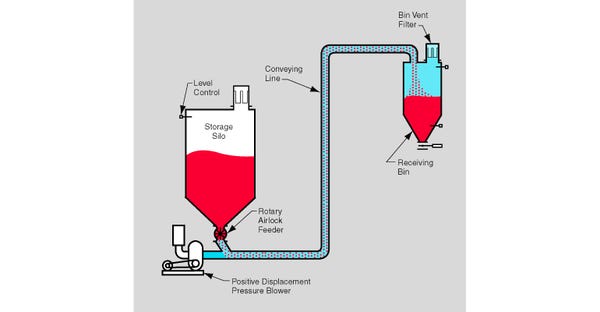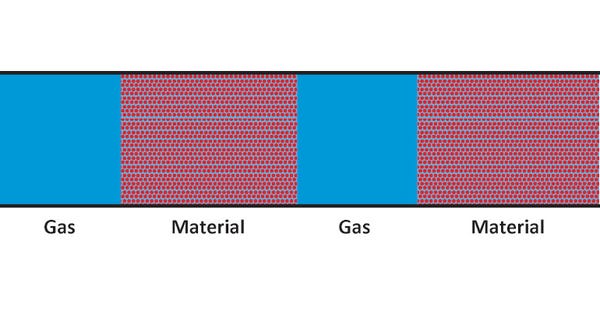What is the Difference Between Dense Phase and Dilute Phase Conveying?
This article will attempt to answer this question and explain the differences between these two types of systems.
December 1, 2022

Jacqui Meany, marketing manager, Dynamic Air Inc.
Pneumatic conveying systems are generally classified as either being dense phase or dilute phase. But what does this mean? And what do these systems generally look like? This article will attempt to answer this question and explain the differences between these two types of systems.
First, let’s get some definitions out of the way. “Gas” will refer to the conveying gas. This will most commonly be air. However, there are applications where other gasses are used to convey. Nitrogen is probably the most common “other” gas used as it is a relatively inexpensive inert gas to produce, since 78% of our atmosphere is nitrogen. Nitrogen is commonly used where oxidation of the material conveyed is a concern, or for the conveying of explosive materials. Second, “material” will refer to the solids that are being conveyed. Third, “efficiency” will refer to the power required relative to the rate and distance of the system. The system that uses less power (gas) conveying the same rate and distance is more efficient from a power (gas use) standpoint. Now, let’s get to the interesting part.
Dilute Phase Systems
Dilute phase pneumatic conveying systems generally are described as the constant metering of material into a high-velocity gas stream. The most common feeder being a rotary airlock feeder. Dilute phase systems can operate under either pressure or vacuum conditions. Below is an example of a common design for a pressure dilute phase pneumatic conveying system.

Although a dilute phase pneumatic conveying system commonly looks like the system above, what really defines a dilute phase system are the conditions inside the convey pipe while conveying. The determining characteristic is that, with a dilute phase system, the material conveys at high velocities close to the gas velocity and the material appears to be suspended in the gas stream (see below). A vacuum cleaner is a good example of this: a high gas-to-material ratio.

With dilute phase system designs, it is not uncommon for half of the total system power to be used just to move the conveying gas through an empty convey pipe. This is due to the low operating pressure and the high velocity of the gas flow. As such, these systems become less practical as the conveying rate requirement increases or the conveying distance increases. It is also not uncommon with dilute phase conveying systems to have gas velocities more than 5,000 ft/min. This makes a dilute phase pneumatic conveying system also less practical for applications handling fragile or abrasive materials since high material velocities cause more wear and particle damage.
Why is the conveying distance a factor? Because the power required to move a material increases as the conveying distance increases. Like carrying a heavy bag over a distance, it is more work to carry that heavy bag over a distance of 1 mile vs 10 ft. For this reason, if the application is high rate or long distance, efficiency becomes increasingly more of a concern.

Dense phase pneumatic conveying systems generally are described as material being pushed or extruded through the convey pipe by the pressure of the conveying gas. A good analogy would be a beer keg dispensing beer. Dense phase pneumatic conveying systems can operate under either pressure or vacuum conditions. Below is an example of a common design for a pressure dense phase pneumatic conveying system.
Dense Phase Pneumatic Conveying System
Although a dense phase pneumatic conveying system commonly looks like the system above, what really defines a dense phase system are the conditions inside the convey pipe while conveying. The determining characteristic is that, with a dense phase system, the material flows in “slugs”. What this means is that the material moves through the convey pipe at a bulk density very close the bulk density measured at rest, and gas pockets exist between the material “slugs” (see below):
A common misconception is that these “slugs” are somehow created by the pneumatic conveying system. This is false. The dense phase conveying system can maintain these slugs and prevent smaller slugs from combining into fewer larger slugs, but these slugs form naturally since the conveyed material and the conveying gas separate naturally like oil and water.
With a dense phase pneumatic conveying system, the conveying velocities are generally lower than dilute phase systems. Conveying velocities slower than an average walking speed can be attained with a dense phase system. As such, dense phase pneumatic conveying systems are generally suitable for applications with long conveying distances, high rates, or for conveying fragile or abrasive materials.
But what about the rate? If the velocity is low, isn’t the rate going to be low also? The devil is in the details. The important detail here is the conveying density. The conveying density is the density of the mix of the material and conveying gas in the convey pipe. If we were to stop the conveying process, remove a section of pipe, and weigh the contents, we can calculate the conveying density in the convey pipe. With a dense phase pneumatic conveying system, the conveying density in the convey pipe is typically around 50% of the bulk density of the material at rest. In contrast, the conveying density inside a central dust collector pipe of a dilute phase system is typically double the density of air. That is very low. Dense phase pneumatic conveying systems can have a conveying density of 20-400x the conveying density of dilute phase systems.
Beyond Dilute and Dense Phase
It is important to note that while most pneumatic conveying systems fall into either the dilute phase or dense phase category, there are some exceptions, extremes, and in-betweens. Pneumatic conveying systems can be adjusted to operate in a variety of spectrums from pure suspension flow to pure slug flow. There are many different types of dilute phase and dense phase systems. The caveat with this is that when the material changes slightly, the pipe route changes, or the convey distance changes (multiple destinations, for example), the optimal conveying mode will change as well. So, beware the finely tuned test scenario that demonstrates the “perfect” conveying mode. This may not be possible in practice if the material is not consistent, or the application calls for multiple destinations which have different convey distances and pipe routes.
In addition to there being many different types of dilute and dense phase systems, there are other technologies that should be taken into consideration. This would include how booster (or air saver) technology maintains the slug length and quantity in the convey pipe. But that is a discussion for another article.
Jacqui Meany is marketing manager, Dynamic Air Inc. (St. Paul, MN). Dynamic Air has been designing and manufacturing pneumatic conveying systems for the processing industries for more than 50 years. For more information, visit www.dynamicair.com.
You May Also Like


